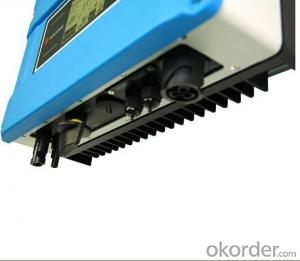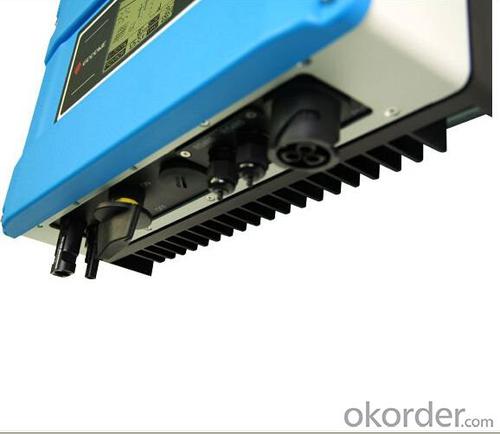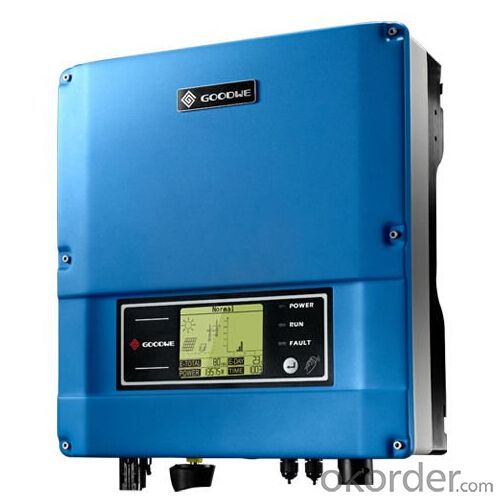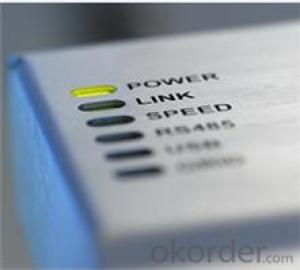Fuji Solar Inverter GW4000-SS On Grid Solar Inverter
OKorder Service Pledge
Quality Product, Order Online Tracking, Timely Delivery
OKorder Financial Service
Credit Rating, Credit Services, Credit Purchasing
You Might Also Like
GW4000-SS photovoltaic inverter is suitable for home rooftop photovoltaic system, designed under modern industrial concept.
There are three colors for option with fashionable appearance.
According to the test results of PHOTON laboratory, the medium irradiation efficiency is 96.9% and high irradiation efficiency is 97.1%.
It has obtained Double A Certificates. It holds a safe lead among the same level of products in the world.
Datasheet
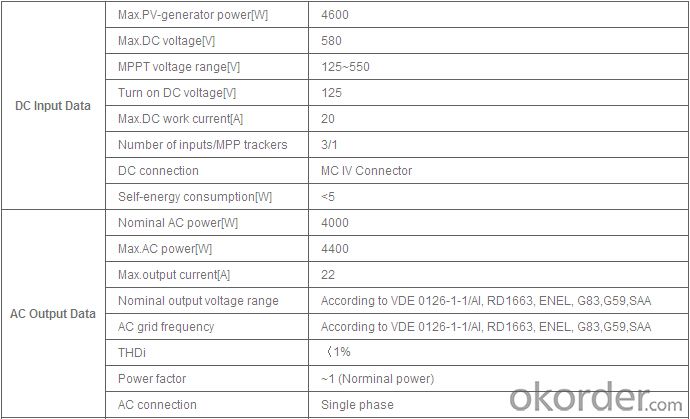
- Q: How does MPPT technology work in solar inverters?
- MPPT (Maximum Power Point Tracking) technology in solar inverters works by continuously adjusting the operating voltage and current of the solar panels to ensure the maximum power output. It does this by constantly monitoring the voltage and current of the solar panels and finding the optimal point (maximum power point) at which the panels can deliver the most power. This is achieved by varying the load on the panels to match their impedance with the maximum power point. MPPT technology maximizes the efficiency of solar power generation by extracting the maximum available power from the panels under varying environmental conditions such as shading, temperature changes, and panel degradation.
- Q: How does a solar inverter handle voltage regulation in the grid?
- A solar inverter handles voltage regulation in the grid by constantly monitoring the voltage levels and adjusting its output accordingly. If the grid voltage is too high, the inverter reduces its output to prevent overloading and potential damage to connected devices. Conversely, if the grid voltage is too low, the inverter increases its output to compensate for the deficit and maintain a stable voltage supply. This regulation ensures that the solar energy generated by the inverter is seamlessly integrated into the grid while adhering to grid voltage standards.
- Q: Can a solar inverter be used with a solar tracker system?
- Yes, a solar inverter can be used with a solar tracker system. A solar inverter is responsible for converting the direct current (DC) produced by solar panels into alternating current (AC) that can be used to power electrical devices. A solar tracker system, on the other hand, is designed to maximize the efficiency of solar panels by orienting them towards the sun throughout the day. By using a solar inverter in conjunction with a solar tracker system, the generated electricity can be efficiently converted and used for various applications.
- Q: What is the role of a solar inverter in preventing system downtime?
- The role of a solar inverter in preventing system downtime is to convert the direct current (DC) produced by solar panels into alternating current (AC) that can be used to power electrical devices and to feed excess energy back into the grid. By maintaining a stable and reliable flow of electricity, solar inverters help prevent disruptions and downtime in the solar energy system, ensuring continuous operation and maximizing energy efficiency.
- Q: How does a solar inverter handle voltage sags or swells in the grid?
- A solar inverter handles voltage sags or swells in the grid by continuously monitoring the voltage levels. When it detects a sag or swell, it adjusts its internal circuitry to regulate the output voltage accordingly. This ensures that the connected solar panels continue to operate within their optimal voltage range, minimizing any negative impact on the overall power generation system.
- Q: How does a solar inverter handle grid synchronization during startup?
- During startup, a solar inverter handles grid synchronization by first ensuring that the grid is stable and within acceptable voltage and frequency ranges. It then synchronizes its output voltage and frequency with the grid by monitoring its phase angle and adjusting it accordingly. This synchronization process allows the solar inverter to safely and seamlessly connect to the grid, ensuring smooth power transfer and operation.
- Q: Can a solar inverter be used in commercial or industrial applications?
- Yes, a solar inverter can be used in commercial or industrial applications. In fact, solar inverters are commonly used in these settings to convert the direct current (DC) generated by solar panels into alternating current (AC) that can be used to power various electrical devices and equipment in commercial and industrial buildings.
- Q: How does a solar inverter protect against lightning strikes?
- A solar inverter typically protects against lightning strikes by incorporating surge protection devices and grounding systems. These features help to divert the excess energy caused by a lightning strike away from the sensitive electronic components of the inverter, preventing damage and potential electrical hazards.
- Q: Can a solar inverter be used in low light conditions?
- Yes, a solar inverter can be used in low light conditions. However, the efficiency of the inverter may be reduced as it relies on sunlight to convert the DC power generated by solar panels into AC power. In low light conditions, the solar panels produce less electricity, resulting in a lower output from the inverter.
- Q: What is the role of a solar inverter in fault ride-through capability?
- The role of a solar inverter in fault ride-through capability is to ensure that the solar power system remains operational and stable during grid faults or disturbances. The inverter is responsible for detecting fault conditions and adjusting its output to mitigate the impact of the fault on the system. By providing fault ride-through capability, the solar inverter helps maintain grid stability and ensures continuous power supply from the solar panels even in the presence of faults.
Send your message to us
Fuji Solar Inverter GW4000-SS On Grid Solar Inverter
OKorder Service Pledge
Quality Product, Order Online Tracking, Timely Delivery
OKorder Financial Service
Credit Rating, Credit Services, Credit Purchasing
Similar products
Hot products
Hot Searches
Related keywords
